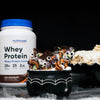The Invention of the Calorie (And Why It Was Never Meant for Dieting)

Spoiler alert: Calories weren’t invented by dietitians. They were designed to measure how efficiently fuel could power a steam engine.
So how did we go from using calories to heat water... to using them to track our diets?
Let’s break it down.
What Even Is a Calorie?
Before it ever hit a food label, the calorie was a unit of heat. In science-speak, a calorie is the amount of energy needed to raise the temperature of one gram of water by one degree Celsius. That’s it. Just a way to quantify thermal energy.
In the early 1800s, a French physicist named Nicolas Clément began using the term "calorie" in his lectures. His focus? Thermodynamics and fuel efficiency – not six-packs or snack packs.
At the time, scientists were obsessed with one big question:
How much energy can we get from different fuels?
Whether it was coal, wood, or food scraps, they wanted to know how much heat each one could produce. And that’s where the calorie came in, as a tool for engineers.
Enter the Steam Engine
During the Industrial Revolution, steam engines were the lifeblood of progress. They powered trains, factories, and ships, but they needed fuel, and lots of it.
Measuring fuel efficiency wasn’t just helpful, it was essential. Understanding how much energy something could produce helped engineers build better engines and optimize output. The calorie was just a convenient unit of measurement.
So no, the calorie wasn’t invented to count almonds.
It was invented to help machines run more efficiently.
From Machines to Metabolism
It wasn’t until decades later that scientists began wondering:
If fuel gives off energy when burned… what happens when we “burn” food in the body?
That question led to the invention of the bomb calorimeter, a device that measures how much energy food produces when it’s combusted in a sealed chamber.
An American chemist named Wilbur Olin Atwater adapted this tool in the late 1800s. He burned everything from meats and grains to alcohol, tracking the heat each item produced. From there, he calculated the now-famous formula:
-
1 gram of protein = 4 calories
-
1 gram of carbohydrate = 4 calories
-
1 gram of fat = 9 calories
Atwater's work laid the foundation for modern nutrition science. But even then, the goal wasn’t dieting, it was understanding metabolism, energy needs, and how the human body fuels itself.
The Diet Industry Gets Involved
By the early 20th century, calorie science had been absorbed by doctors, military planners, prisons, and hospitals, anywhere that food had to be rationed or optimized.
But it wasn’t long before popular media caught wind of it, too.
Magazines began publishing calorie counts. Cookbooks listed energy values. By the 1920s, calorie-counting diets were all the rage, especially among women trying to meet increasingly unrealistic beauty standards.
Suddenly, food wasn’t just fuel. It was something to control, restrict, or fear.
The calorie had gone from scientific unit to cultural obsession.
Why the Calorie Doesn’t Tell the Full Story
Here’s the twist: while calorie math looks simple on paper, the human body is anything but simple.
A few key issues:
-
Digestion isn't a controlled burn. We absorb nutrients differently depending on gut health, food type, and individual variability.
-
Not all calories are metabolized equally. 100 calories of almonds will leave you feeling much differently than 100 calories of soda.
-
Exercise and metabolism vary wildly. Your “calories burned” on a treadmill are estimates at best. Factors like sleep, stress, muscle mass, and hormone levels all impact energy use.
In short: calorie math is useful, but incomplete.
So What Should We Take Away from All This?
The next time you glance at a nutrition label, just know: the calorie wasn’t born out of a diet trend, it was born in a physics lab.
It’s a powerful way to measure energy. It’s helped shape modern nutrition, sports science, and how we understand the body. But like any tool, it has its limits.
Calories can help you structure your goals and understand your intake, but they don’t capture the full picture. They don’t account for food quality, digestion, or how your body uniquely responds to what you eat and how you move.
So keep tracking if it helps. Use the numbers. But remember: calories weren’t meant to run your life, they were meant to measure energy, and that’s still what they do best.








